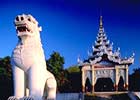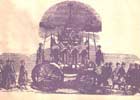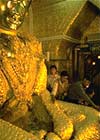|
  Things
have changed somewhat since then, but it is not vastly
different. After all Mandalay, like much of Myanmar tends to
develop at a slow meandering pace compared to most developing
countries and in fact time seems to stand still more often than
not. Things
have changed somewhat since then, but it is not vastly
different. After all Mandalay, like much of Myanmar tends to
develop at a slow meandering pace compared to most developing
countries and in fact time seems to stand still more often than
not.
 Mandalay
is a relatively young city that got its name from Mandalay Hill,
situated at the north-east corner of present day Mandalay.
According to the legends, Lord Buddha had prophesied that a
great city would be founded at the foot of Mandalay Hill. Mandalay
is a relatively young city that got its name from Mandalay Hill,
situated at the north-east corner of present day Mandalay.
According to the legends, Lord Buddha had prophesied that a
great city would be founded at the foot of Mandalay Hill.
 It
fell on King Mindon Min's shoulders to make the legend a reality
and the building of the new capital was planned in the year 1857
and in 1859 it was inaugurated. Most of the monuments including
the Mandalay Palace, the city walls, pagodas and monasteries
were built in that year or soon after. It
fell on King Mindon Min's shoulders to make the legend a reality
and the building of the new capital was planned in the year 1857
and in 1859 it was inaugurated. Most of the monuments including
the Mandalay Palace, the city walls, pagodas and monasteries
were built in that year or soon after.
 Once
built the city did not remain the capital of Myanmar for long.
Mindon was succeeded by a disastrous Thibaw Min and in 1885
Mandalay was taken by the British. Once
built the city did not remain the capital of Myanmar for long.
Mindon was succeeded by a disastrous Thibaw Min and in 1885
Mandalay was taken by the British.
 The
British, after taking control of Myanmar shifted their capital
to Rangoon (now Yangon) nearly 700 km to the south in lower
Myanmar. Thibaw Min and his equally notorious queen were exiled
and ‘the Golden City’ (as it was known) became just another
outpost of the British Empire. The
British, after taking control of Myanmar shifted their capital
to Rangoon (now Yangon) nearly 700 km to the south in lower
Myanmar. Thibaw Min and his equally notorious queen were exiled
and ‘the Golden City’ (as it was known) became just another
outpost of the British Empire.
 During
World War II, most of the Mandalay Palace (which had been built
of wood) was destroyed by a fire, this though has since been
rebuilt. Today, Mandalay is the second largest city of Myanmar
and a place of great tourism importance. During
World War II, most of the Mandalay Palace (which had been built
of wood) was destroyed by a fire, this though has since been
rebuilt. Today, Mandalay is the second largest city of Myanmar
and a place of great tourism importance.
|

 Things
have changed somewhat since then, but it is not vastly
different. After all Mandalay, like much of Myanmar tends to
develop at a slow meandering pace compared to most developing
countries and in fact time seems to stand still more often than
not.
Things
have changed somewhat since then, but it is not vastly
different. After all Mandalay, like much of Myanmar tends to
develop at a slow meandering pace compared to most developing
countries and in fact time seems to stand still more often than
not. Mandalay
is a relatively young city that got its name from Mandalay Hill,
situated at the north-east corner of present day Mandalay.
According to the legends, Lord Buddha had prophesied that a
great city would be founded at the foot of Mandalay Hill.
Mandalay
is a relatively young city that got its name from Mandalay Hill,
situated at the north-east corner of present day Mandalay.
According to the legends, Lord Buddha had prophesied that a
great city would be founded at the foot of Mandalay Hill. It
fell on King Mindon Min's shoulders to make the legend a reality
and the building of the new capital was planned in the year 1857
and in 1859 it was inaugurated. Most of the monuments including
the Mandalay Palace, the city walls, pagodas and monasteries
were built in that year or soon after.
It
fell on King Mindon Min's shoulders to make the legend a reality
and the building of the new capital was planned in the year 1857
and in 1859 it was inaugurated. Most of the monuments including
the Mandalay Palace, the city walls, pagodas and monasteries
were built in that year or soon after. Once
built the city did not remain the capital of Myanmar for long.
Mindon was succeeded by a disastrous Thibaw Min and in 1885
Mandalay was taken by the British.
Once
built the city did not remain the capital of Myanmar for long.
Mindon was succeeded by a disastrous Thibaw Min and in 1885
Mandalay was taken by the British. The
British, after taking control of Myanmar shifted their capital
to Rangoon (now Yangon) nearly 700 km to the south in lower
Myanmar. Thibaw Min and his equally notorious queen were exiled
and ‘the Golden City’ (as it was known) became just another
outpost of the British Empire.
The
British, after taking control of Myanmar shifted their capital
to Rangoon (now Yangon) nearly 700 km to the south in lower
Myanmar. Thibaw Min and his equally notorious queen were exiled
and ‘the Golden City’ (as it was known) became just another
outpost of the British Empire. During
World War II, most of the Mandalay Palace (which had been built
of wood) was destroyed by a fire, this though has since been
rebuilt. Today, Mandalay is the second largest city of Myanmar
and a place of great tourism importance.
During
World War II, most of the Mandalay Palace (which had been built
of wood) was destroyed by a fire, this though has since been
rebuilt. Today, Mandalay is the second largest city of Myanmar
and a place of great tourism importance.